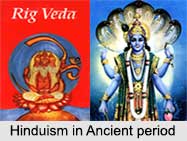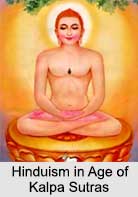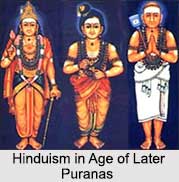 Hinduism in Ancient period dates back to 2000 B.C. This was also known as the Vedic Age. It can be divided into the age of the Mantras, the age of the Brahmanas and the age of the Upanishads. History of Hinduism begins with the composition of the hymns which are recorded in the Rig Veda. The religious poets in the Veda, group their way towards the Eternal Spirit. Several Gods have been described in epithets. Such overlapping among the divine forces made people to believe that all is one in essence. Sometimes it is seen that the creative power which is common to several Gods are personified and considered as a supreme power for a time. In this way a series of divinities are identified.
Hinduism in Ancient period dates back to 2000 B.C. This was also known as the Vedic Age. It can be divided into the age of the Mantras, the age of the Brahmanas and the age of the Upanishads. History of Hinduism begins with the composition of the hymns which are recorded in the Rig Veda. The religious poets in the Veda, group their way towards the Eternal Spirit. Several Gods have been described in epithets. Such overlapping among the divine forces made people to believe that all is one in essence. Sometimes it is seen that the creative power which is common to several Gods are personified and considered as a supreme power for a time. In this way a series of divinities are identified.
Hinduism in Age of Brahmanas
In the age of Brahmanas, sacrifices gained much importance. In this age, the idea was developed that men owed a debt to the Gods, the Rishis, the Pitris and the animals. The four ashrams and the four varnas were organized which were first mentioned in the later portion of the Rig Veda.
Hinduism in the Age of the Upanishads
The age of the Upanishads witnessed a renaissance in Hinduism. In this age the foundations of Hinduism was well laid. Brahman, Atma, Moksha, Samsara, Karma, Upasana and Jnana were the new conceptions of this age.
Hinduism in Age of Kalpa Sutras
The age of Kalpa Sutras commences from 560 B.C.-200 B.C. This period extends from the birth of Buddha to the fall of the Mauryan Empire. Lord Buddha was born around 566 B.C., and Lord Mahavira, the founder of Jainism was born around 547 B.C. Before the rise of Buddhism and Jainism, Magadha rose into prominence in the 6th century B.C. This period was the golden period of Buddhism. Jainism is the only one that survived in India of the many creeds that arose in opposition to Vedic orthodoxy during this period. Hinduism was never obscured by Buddhism or Jainism despite of these developments.
 Hinduism in Epic Age
Hinduism in Epic Age
Epic age ranges from 200 B.C.-300 A.D. After the fall of the Mauryan Empire, there was a revival of Hinduism due to the decline that Buddhism suffered. The Ashwamedha sacrifice which was performed by Pushyamitra Sunga, the founder of Sunga dynasty on the ruins of the Mauryan Empire is probably the signal of second Renaissance of Hinduism.
Now there is a personal God who has created all things and upholds the order of the universe and responds to the call of devotion. The popularization of the doctrine of incarnation has been one of the noteworthy developments in this age. There was a more systematic organization of temple-worship in this period.
By this time, Hinduism had developed all the main features with like the conception of the impersonal Brahman and the personal Ishwara, the supreme authority of the Veda, the Law of Karma and rebirth, concept of Varna-ashram-dharma and Dharma-Artha-Kama and many more.
Hinduism in Age of Puranas
The age of Puranas extended from 300 A.D.-650 A.D. This is the Gupta period. The popularization of Hindu dharma which began in the epic age was carried on to a further stage by the Puranas. There is not much advance in religious thought in the Puranas except the extension of the doctrine of Avatars and the concept of Shakti who is personified as Mother Goddess.
 The school of philosophies like Mimamsa, Vedanta, Samkhya, Yoga, Nyaya and Vaisheshika are known as Darshanas as it puts forward a view of life. The philosophies of Vedanta became popular among the educated classes that the work was raised to the rank of a Prasthana – a scripture of authority.
The school of philosophies like Mimamsa, Vedanta, Samkhya, Yoga, Nyaya and Vaisheshika are known as Darshanas as it puts forward a view of life. The philosophies of Vedanta became popular among the educated classes that the work was raised to the rank of a Prasthana – a scripture of authority.
Hinduism in Age of Later Puranas
This period includes 650 A.D.-1000 A.D. This age extends from the death of Harsha to the Muslim conquest of Hindustan. The Rajput clans witnessed a rise in this age. The Advaita philosophy was developed in this period. Shankaracharya"s philosophy of Advaita had influenced some sectarian philosophies; those of the Bhagavatas, the Shaktas and the Northern school of Shaivism. There appeared much earlier in this period, the great Bhakti movement in Southern India which runs on Vaishnavism and Shaivism. In both Vaishnavism and Shaivism, there were saints who composed devotional songs in the vernacular. The Vaishnava saints are known as Alvars. There Shaiva saints are called Nayanmars.
Some repulsive manifestations of Shaivism in the practices of sects like Pashupatas and Kapalikas also became popular. Shaktism also had a remarkable development in this period as the Tantras were now systematized.




















